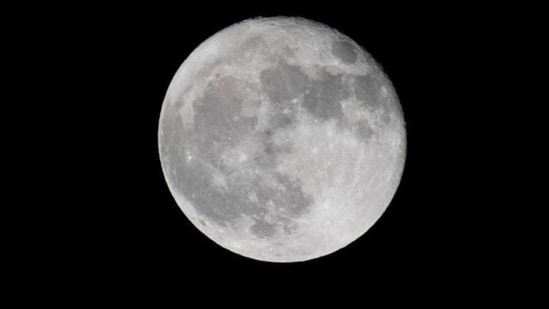‘Moon has ample oxygen to sustain 8 billion people for 100k yrs, but not in gaseous form’: Report
The Conversation report, published on November 10, said there is plenty of oxygen on the Moon, which is the Earth’s only natural satellite, but it is not in gaseous form.

In October this year, the Australian Space Agency signed a deal with NASA to send a rover to the Moon to collect lunar rocks that could provide breathable oxygen.(Reuters file photo)
Published on Nov 22, 2021 01:34 PM IST
Written by Harshit Sabarwal | Edited by Sohini Goswami, New Delhi
A study has claimed that the Moon’s top layer alone has enough oxygen to sustain as many as eight billion people for 100,000 years. According to a report by the Australian website The Conversation, the top layer of rocks on the Moon, called regolith, is made up of approximately 45 per cent oxygen.
The report, published on November 10, said there is plenty of oxygen on the Moon, which is the Earth’s only natural satellite, but it is not in gaseous form.
“Although the Moon does have an atmosphere, it’s very thin and composed mostly of hydrogen, neon and argon. It’s not the sort of gaseous mixture that could sustain oxygen-dependent mammals such as humans,” it added.
In October this year, the Australian Space Agency signed a deal with NASA to send a rover to the Moon to collect lunar rocks that could provide breathable oxygen.
The Conversation report on November 10 further said that oxygen can be found in many minerals in the ground ‘around us’, adding the Moon is majorly made up of the same rocks found on planet Earth.
“Minerals such as silica, aluminium, and iron and magnesium oxides dominate the Moon’s landscape. All of these minerals contain oxygen, but not in a form our lungs can access,” it added.
Using Electrolysis to extract oxygen from minerals
The report has suggested that Electrolysis technique can be used to extract oxygen from silica, aluminium, iron and other minerals found on the Moon.
“In this case, the oxygen is produced as a byproduct. On the Moon, the oxygen would be the main product and the aluminium (or other metal) extracted would be a potentially useful byproduct,” it said.
However, for the procedure to be sustainable, it has to be supported by solar energy on any other sources of energy on the Moon. “Extracting oxygen from regolith would also require substantial industrial equipment.”
Earlier this year, a start-up from Belgium said that it was making three experimental reactors to improve the process of making oxygen through electrolysis. The Space Applications Services is planning to send such reactors to the Moon by 2025, the report said.
Published on Nov 22, 2021 01:34 PM IST
Written by Harshit Sabarwal | Edited by Sohini Goswami, New Delhi
A study has claimed that the Moon’s top layer alone has enough oxygen to sustain as many as eight billion people for 100,000 years. According to a report by the Australian website The Conversation, the top layer of rocks on the Moon, called regolith, is made up of approximately 45 per cent oxygen.
The report, published on November 10, said there is plenty of oxygen on the Moon, which is the Earth’s only natural satellite, but it is not in gaseous form.
“Although the Moon does have an atmosphere, it’s very thin and composed mostly of hydrogen, neon and argon. It’s not the sort of gaseous mixture that could sustain oxygen-dependent mammals such as humans,” it added.
In October this year, the Australian Space Agency signed a deal with NASA to send a rover to the Moon to collect lunar rocks that could provide breathable oxygen.
The Conversation report on November 10 further said that oxygen can be found in many minerals in the ground ‘around us’, adding the Moon is majorly made up of the same rocks found on planet Earth.
“Minerals such as silica, aluminium, and iron and magnesium oxides dominate the Moon’s landscape. All of these minerals contain oxygen, but not in a form our lungs can access,” it added.
Using Electrolysis to extract oxygen from minerals
The report has suggested that Electrolysis technique can be used to extract oxygen from silica, aluminium, iron and other minerals found on the Moon.
“In this case, the oxygen is produced as a byproduct. On the Moon, the oxygen would be the main product and the aluminium (or other metal) extracted would be a potentially useful byproduct,” it said.
However, for the procedure to be sustainable, it has to be supported by solar energy on any other sources of energy on the Moon. “Extracting oxygen from regolith would also require substantial industrial equipment.”
Earlier this year, a start-up from Belgium said that it was making three experimental reactors to improve the process of making oxygen through electrolysis. The Space Applications Services is planning to send such reactors to the Moon by 2025, the report said.
No comments:
Post a Comment